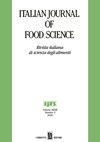从中药中提取生物活性化合物的新型级联方法
IF 3.3
4区 农林科学
Q2 FOOD SCIENCE & TECHNOLOGY
引用次数: 2
摘要
本研究的目的是比较一种新型的级联提取方法与传统的固液提取方法,这两种方法都是在超声辅助下进行的。级联萃取法包括用相同的氢醇溶剂进行的一系列连续萃取,该溶剂从一种草药重复使用到另一种草药。在实践中,首先使用氢醇溶液提取一种植物草本植物。所得的提取物然后被重复用于提取第二种草药。这个过程重复的次数和组成最终配方的草药的数量一样多。这种方法的主要优点是,首先,与每个提取步骤都需要新鲜溶剂的单独提取程序相比,溶剂的需求较低。此外,对两种提取方法(固液萃取法和级联萃取法)的提取物进行了抗氧化(DPPH、ORAC和FRAP)和总酚含量(TPC)的表征。结果表明,固液萃取法得到的总酚和TAC的得率与级联萃取法相近。此外,对提取物的高效液相色谱分析表明,两种方法在电化学检测器(CoulArray)或光谱二极管阵列检测器(DAD)分析时都能得到相似的色谱图谱。然而,我们的研究结果支持级联提取方法获得更丰富的小峰提取物,显示出更复杂的生物活性谱的观点。这样的结果可以解释为,在串联提取过程中使用的溶剂不仅富含抗氧化剂,而且还富含植物表面活性剂,如皂苷,这增加了溶剂的溶解度。综上所述,本研究表明,级联萃取法不仅可以提供与传统固液萃取法相似的酚类产率和抗氧化能力,而且与传统固液萃取法相比,具有更复杂的生物活性特征,并且消耗的溶剂较少。本文章由计算机程序翻译,如有差异,请以英文原文为准。
A novel cascade approach to extract bioactive compounds from officinal herbs
This research aims to compare a novel cascade extraction method with a conventional solid–liquid extraction method, both assisted by ultrasounds. The cascade extraction method consists of a sequential series of extractions performed with the same hydroalcoholic solvent, which is reused from one herb to the other. In practice, a hydroalcoholic solution is firstly used to extract one botanical herb. The resulting extract is then reused for the extraction of a second herb. The process is repeated as many times as the number of herbs composing the final formulation. The main advantage of this approach is firstly the lower need of solvents compared with the individual extraction procedures, where a fresh solvent is needed on each extraction step. Furthermore, extracts of the two methods (solid liquid vs cascade extraction) were characterized with several antioxidant assays (DPPH, ORAC, and FRAP) and total phenolic content (TPC). The results show that the solid–liquid extraction method achieves similar yields to total phenols and similar TAC in comparison to the extracts obtained by the cascade extraction method. Also, the HPLC analysis of the extracts showed that both methods lead to similar chromatographic profiles either when analyzed by an electrochemical detector (CoulArray) or by a spectrometric diode array detector (DAD). However, our findings support the idea that the cascade extraction method obtains extracts richer of minor peaks, showing a more complex bioactive profile. Such results could be explained considering that the solvent used during the series of cascade extractions was enriched not only by antioxidants but also by plant surfactants, like saponins, which increase the solvent solubility. Overall, this research shows that the cascade extraction method can not only provide officinal herb extracts with similar phenolic yield and antioxidant capacity than conventional solid–liquid extraction but also with a more complex bioactive profile compared to traditional solid–liquid extraction and with a minor consumption of solvents.
求助全文
通过发布文献求助,成功后即可免费获取论文全文。
去求助
来源期刊

Italian Journal of Food Science
工程技术-食品科技
CiteScore
4.20
自引率
0.00%
发文量
33
审稿时长
>36 weeks
期刊介绍:
"Italian Journal of Food Science" is an international journal publishing original, basic and applied papers, reviews, short communications, surveys and opinions on food science and technology with specific reference to the Mediterranean Region. Its expanded scope includes food production, food engineering, food management, food quality, shelf-life, consumer acceptance of foodstuffs, food safety and nutrition, energy and environmental aspects of food processing on the whole life cycle.
Reviews and surveys on specific topics relevant to the advance of the Mediterranean food industry are particularly welcome.
 求助内容:
求助内容: 应助结果提醒方式:
应助结果提醒方式:


